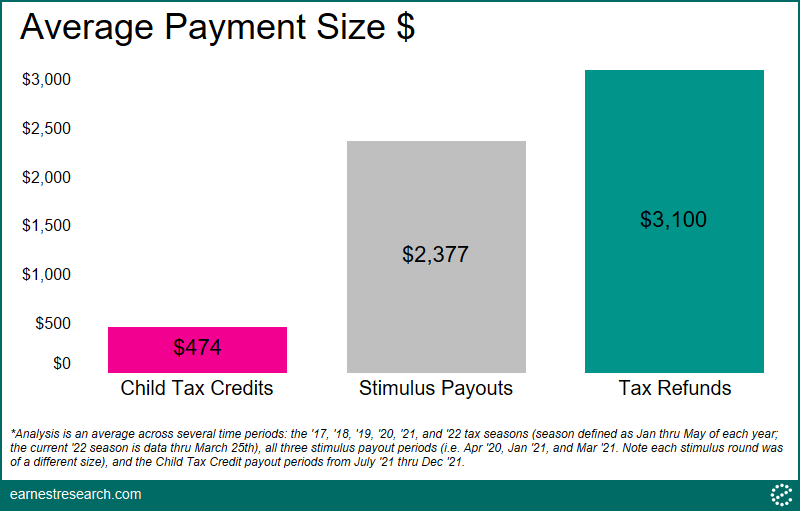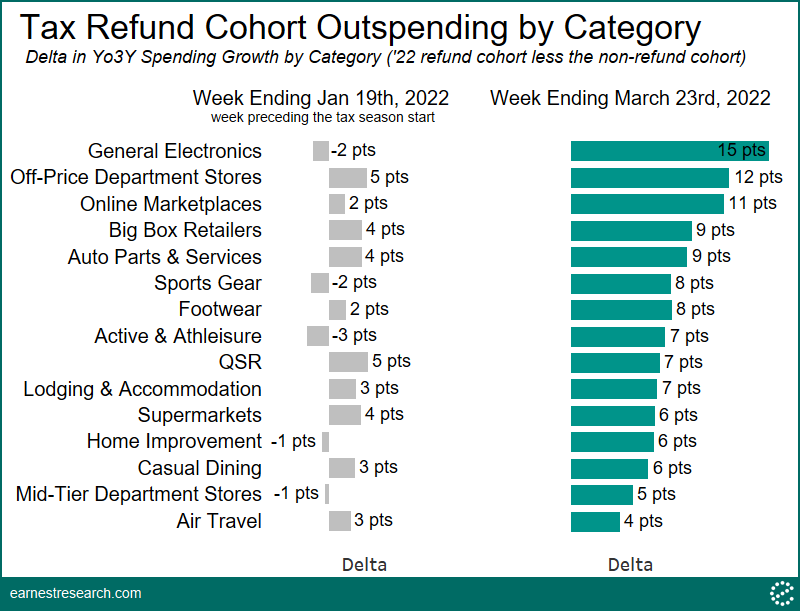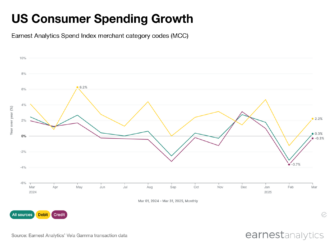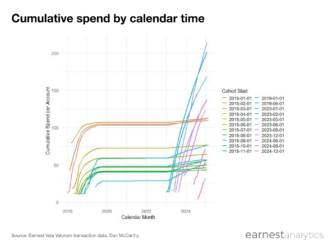Shoppers spending 2022 tax refunds on electronics and apparel
Key takeaways:
- With no more stimulus checks, lower federal deposits this tax season will likely cause YoY headwinds for retailers
- 2022 refund recipients have begun to outspend non-recipients through late March
- General Electronics and Off-Price Department Stores are benefitting the most from spending by refund recipients, while Air Travel and Restaurants see smaller lift
Federal deposits shrink after Covid-19 stimulus ends
Annual federal tax refunds have been a reliable source of additional spending cash for American taxpayers. Covid-19 upended the regular February-April cadence of payments as many households received additional stimulus payouts and tax credits that almost doubled the amount normally deposited by the government. This tax season marks a return to more normal refund behavior, which could signal sales declines for retailers who benefited from consumers’ extra cash in 2020 and 2021.

Bigger tax refunds, but fewer total dollars
The federal tax refund between 2017 and 2022 averaged $3,100 in the data*, 30% larger than the average stimulus payment dispensed in 2020 and 2021, and only slightly higher than the combined stimulus and child tax credit. The key difference is that not all Americans receive tax refunds, while most households received stimulus. The breadth of stimulus checks pushed consumer spending beyond the normal refund bump in years past.
The impact of federal deposits could be partially offset by larger refunds, with the IRS reporting a 13% YoY increase in average refund size so far. This growth is possibly due to eligible stimulus recipients who were not included in previous payouts and will likely be getting their checks added to their refunds.

Refund recipients already outspending non-recipients
Tax refund recipients began outspending their non-recipient peers once the tax season began this year; a gap that widened to 7 points into the third week of March. Indeed, outspending from refund recipients has generally always occurred: in 2019, (i.e. before COVID and the related stimulus-related noise), tax refund recipients outspent their peers by 3 points throughout the 2019 tax season.

General Electronics and Off-Price Department Stores benefitting
Refund recipients spending on General Electronics outgrew non-recipients by 15 points in the trailing 4 week period ended March 23, after under performing non-recipients in the week before tax refunds began. Off-Price Department Stores (12 points), Online Marketplaces (11 points), and Big Box Retailers (9 points) similarly benefited from spending by refund recipients. The benefit to categories still recovering from quarantine lockdown restrictions is less clear–refund recipients were already outspending on QSR, Casual Dining, and Air Travel before refunds began.

Notes
*The IRS’ filing statistics over the years has shown an average direct deposit refund size of $2,921 through the tax seasons of 2017 through 2021. The increased refund size this year has [so far] bumped up this six-season average to $3,005.
The IRS has so far reported sending 49.96 million (+6% YoY) direct deposit refunds during the current tax season to date, worth $168.6 billion (+20% YoY), yielding an average refund size of $3,374 (+13% YoY). They note, however, that the current filing season began on January 24th, 2022, an ~18 day head start vs. last year’s filing season which began on February 12th, 2021. Also, the refund size is likely higher this season because it may include stimulus payments for people who were supposed to receive one already but did not. Earnest data’s average refund size has consistently over-indexed the reported refund size since 2017, except during the 2020 season which was extended due to the pandemic.











